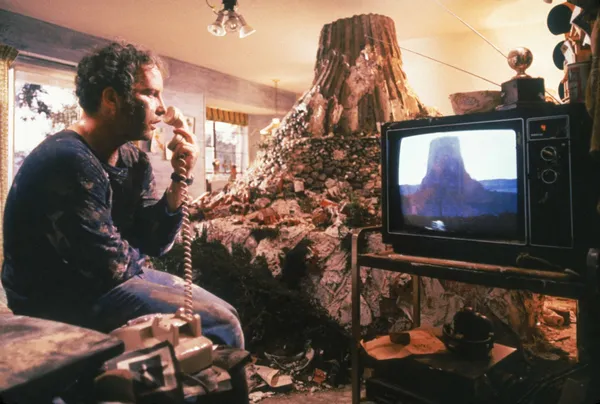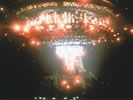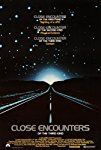Eye For Film >> Movies >> Close Encounters Of The Third Kind (1977) Film Review

Pauline Kael, the great acid-quilled critic for the New Yorker compared E.T. and Close Encounters to "a boy soprano singing with joy". A sly knock at Spielberg's age, perhaps, but she touches superbly on his innate gifts - touching our hearts through the senses of sight and sound. Spielberg's films show him as an outstanding communicator, using film and astonishing sound as his intermediate, to our conscious mind. To make one heart speak to another is at the underbelly of Close Encounters Of The Third Kind.
A series of unusual events occur, best described as Close Encounters.
- First kind: a vision of unexplained phenomena (An old man proclaims that the sun came up last night and sang to him.)
- Second kind: proof of extra-terrestrial activity (Planes lost from 1945 appear unharmed, brand new and entirely functional in the desert.)
- Third kind: first contact with E.Ts.

Roy Neary (Richard Dreyfuss), a childlike family man has a Close Encounter of the First Kind - his truck stalls and is bathed in burning light from above, and he begins seeing strong telepathic visions which drive him compulsively. This, along with many other first and second kind close encounters, take a strangely beautiful progression, leading to an inevitable apotheosis. Substance is precious, but Spielberg brilliantly pushes his vision and communicative ideas.
Spielberg's excellent screenplay hits an amazing number of human notes. Neary's ultimate failure to communicate with his family leads to him ostracising them. Parental separation is a Spielberg common theme, and occurs in a number of scenes here too, but never drowns out the other sentiments. It is a series of sad sacrificial scenes, but it is clear that change often has its cost. (Watch the scene where Neary kisses his wife, and keeps his eyes fixed on the stars.)
Visual communication, through Douglas Trumbull's magnificent miniature special effects, fills the screen. Mankind's attempts at visual communication, a grid of colour and light synchronised by sound tones seem woefully primitive by comparison. Also, watch the scene where psychokinetic forces invade Jillian's home and the light of the aliens bears down on the house. It is a great set-piece of Spielberg's visual ingenuity - terrifying, yet awesome. It is by design that we do not know whether the visitors are friendly or not. We empathise with them through a desire to make themselves known. Neary and the others who make it, stand staring transfixed at a divine vision from the heavens, permeated in holy light. It may not be a religious experience for the audience, but it certainly feels like it at the time.
John Williams takes a bow as he refines the five-note signature piece into a great hymn of hope for our futures together. The film is underscored with gentle string work. Williams' work is refined, subtle and beautiful. Moreover, during first contact, there is a wonderful, almost jazzy electronic riff between the two cultures' music communication. It forms a deliriously excessive showpiece of light and sound, along with a great thematic medley during the mesmerising closing credits. The sillyscience babble is quickly silenced in the climax by the five-note keynote symphony of music and light dancing with each other. The deafening bass horns, proving that there is indeed room for some lowbrow laughs in the first contact with an alien species.
Spielberg's passion for making his movie is delivered in a stunning metaphor. Little gestures, such as the wonderful mashed potatoes sculpture scene, mean his early "Starlight" film made in his youth, along with his friends and parents. From this, to the magnificent sculpture of Devil's Tower representing this film. The innate self-reflexion - the film exists as a byproduct of his obsession in creating something extraordinary. Likewise, with the aliens in the film's climax, one of them, a spindly creature steps out, and opens out his arms. Many meanings can be made - a welcoming gesture perhaps? - but none of them less than warm, in spite of the blinding light and cold colours of the creature. Some things are universal. Similarly so with the memorable shot of where the visitors came from, a thousand and one fingers pointing to the heavens.
Human communication is often difficult, too, through our use of language, Claude Lacombe (the great director Francois Truffaut) - an eccentric professor of cultural phenomenon - speaks poor English and requires a translator. During Lacombe's investigation, there are several layers of language translation, but the meanings are usually profoundly clear. Also, when Neary is captured prior to his arrival at Devil's Tower, the camera frames Neary as small and weak against the dominant men speaking openly in secret - in French - which excludes Neary, alienating him far more than the visitors will.
There are so many wonderful moments; from the shaving cream and mashed potatoes, to Truffaut's joyous optimistic speech, the mesmerising special effects, the "When you Wish upon a Star" music rendition, the dazzling and believable descension into Neary's madness and dogmatic belief. We see ourselves in him, the everyman quality that he has, in spite of him being a rotten family man.
Close Encounters effectively crystallises Spielberg's capabilities as an artist - I can think of no other director to manage such a uniform and well-made series of films about human need. I feel equally that no other director could have pulled this off, such a humane fusion of communication and technology. It is easy to see why Kubrick believed that he was the ideal man to pull off his vision for AI.
Kael reminds us, when she noted he is old enough to make his film the way he wants to, but young enough to remember why. When invisible directors can produce masterpieces (Million Dollar Baby - Eastwood keeping directorial flourish to a minimum), by sticking to his guns, the very visible Spielberg produces a joyous movie, one of the best ever made.
A gloriously optimistic, passionate and warm heart beats behind the spectacular special effects and celluloid.
Reviewed on: 26 Apr 2005

















